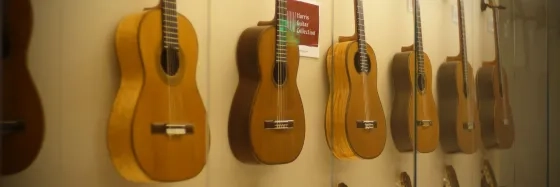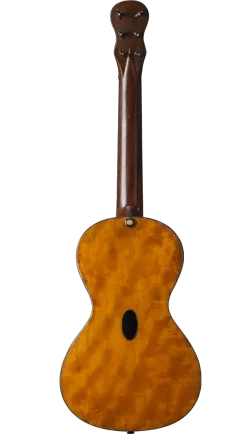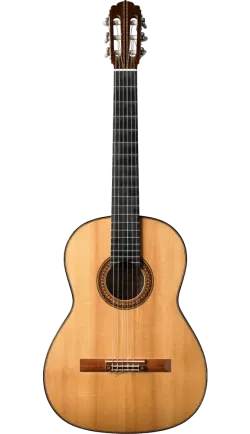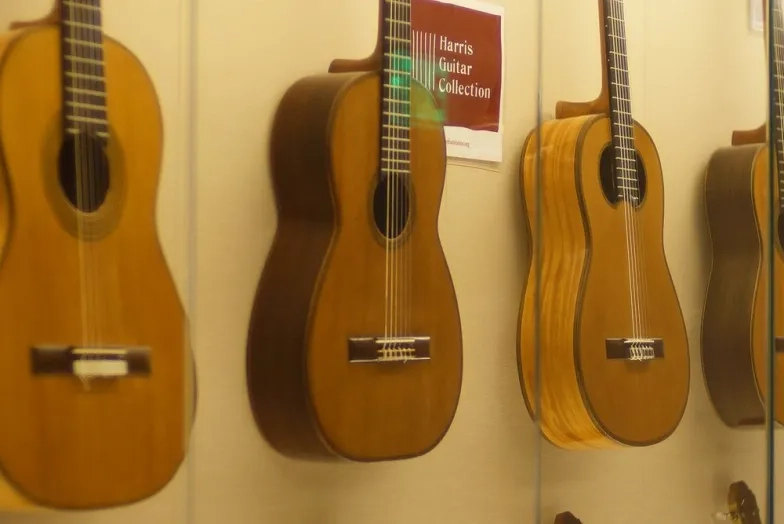About the Harris Guitar Collection
Collegiate Apply / Request Information
The Harris Guitar Collection focuses on two pivotal centuries of modern classic or Spanish guitar making--the 19th and 20th. The Collection--40 instruments--includes the most important luthiers from the period in the early 19th century when the guitar with six strings emerged in southern Spain through the period of its adoption in Europe, Great Britain, South America and Asia by the mid-20th Century.
Videos of Students Performing with the Collection
The Torres Guitar
It was in Spain where, thanks to the genius of the Andalusian guitar maker, Antonio de Torres, the instrument increased in size, resonance, projection and volume. It is tempting (and common) to label Torres the guitar’s Stradivari. And yes, like Strads, the best of Torres’ 150-200 guitars that have survived have an exquisite sound quality that is very rarely matched by other fine luthiers of Torres’ period and after. The story behind Torres’ magic sound can fill books, and have: Jose Romanillos’ Antonio de Torres, Guitar Maker: His Life & Work and Stefano Grondona’s Masterpieces of Guitar Making.
The Collection features a very beautiful Torres from 1888 (SE 112) made with maple back and sides, a wood that Torres used, along with rosewood, for his finest instruments. The guitar was made for a student of Miguel Llobet, a great guitarist from Barcelona, and a colleague of Andres Segovia. One can read more about the guitar and Torres’ innovations in the collection catalogue. It has been recorded on by Marcin Dylla, a former faculty member at SFCM, and the guitar department’s first Chair, George Sakellariou. We hope the beauty of this guitar’s sound will be captured in many future recordings through our Vintage HGC series of CDs and videos.
The Stradivari of the Guitar?
The Strad/Torres comparison is common but problematic. Unlike the violin, the guitar has never achieved a final form, a model about which guitarists from Torres’ time to the present say, “That’s it, we are there.” Well, that’s not entirely true because there are many luthiers who claim that Torres guitars are the ultimate guitar, and many virtuoso guitarists perform exclusively on Torres guitars, most notably among them Stefano Grondona in Italy, Wulfin Lieske in Germany, Carles Trepat in Spain and, on occasion, Pepe Romero in California.
Other notable luthiers that adopted Torres’ innovations in the late 19th and early 20th centuries, such as Arias, Garcia, Simplicio, Manuel Ramirez and Santos have their contemporary fans as well—Pavel Steidl, Matteo Melo and Raphaella Smits. The Collection features beautiful examples from these luthiers.
Still, most guitarists over the centuries have asked luthiers for louder guitars. No violinist in the last 500 years has said, “I want a louder violin.” Perhaps it is the fate of the plucked guitar—and perhaps it’s Achilles heel-- to always reach for more volume, for more presence on the concert stage as a solo and ensemble instrument. Today that impulse finds its voice in guitars—not represented in the Harris Guitar Collection—that have radically deviated from the Torres style with new (non-wood) materials and innovative structural and soundboard bracing designs. For students to experience the difference between Torres style guitars and more radical designs is one of the most important functions of the collection at SFCM. HGC’s Featured Luthier program where contemporary luthiers with new designs can display and discuss their guitars at SFCM was created at the very inception of the Collection’s presence at SFCM.
Before Torres
The collection has several early 19th century guitars that represent the smaller and quieter pre-Torres instruments made by Spanish, French and English makers such as Lacote, Panormo, Gutierrez and Soto y Solares. One of our earliest Guitarrada events was devoted to the theme “The Spanish Guitar Before and After Torres.” Playing the pre-Torres guitars can be surprisingly pleasurable and the sound quality, while quieter and more delicate, is delightful, especially paired with period repertoire. Sometimes the projection of these early guitars, if not the volume, is surprisingly powerful even in a large concert hall. At Guitarrada VII in 2013, the hit of the evening was the 1830 Rene Lacote guitar, a tiny instrument with unusual features such as a second sound hole in the back of the guitar and a double soundboard. The student performer and the audience were amazed at how well this guitar projected in SFCM’s Phyllis Wattis Concert Hall. The special features of the Lacote are now, ironically, part of contemporary luthiery’s quest for more volume—second sound ports and double tops.
After Torres
The great makers of the early to mid-20th century who followed the Torres style, among them Manuel Ramirez and Santos Hernandez in Madrid, Enrique Garcia and Francisco Simplicio in Barcelona, Hermann Hauser in Germany and Robert Bouchet in France created their own schools (their own sound style)—Madrid, Barcelona, German, French, etc.—but remained within the Torres orbit. These guitar-making “schools” are explored with students in our HGC Alcove sessions on the mezzanine off Oak Street’s atrium.
By WWII, with the advent of nylon guitar strings and the concert hall needs of Segovia and his protégés, the guitar was, indeed, getting bigger and marginally louder, but still with the warmth and beauty identified with the Torres sound. Mid- to late 20th century luthiers like Hermann Hauser II, Miguel Rodriguez, Jose Ramirez III, Jose Romanillos, Robert Bouchet and David Rubio listened to their player’s requests for more volume and responded with powerful yet beautifully-voiced Torres-style guitars. HGC includes fine examples from all these luthiers.
And this is where The Harris Guitar Collection rests its case—the sound of Torres in guitars built from the early 1800s through the 20th century. As for the Holy Grail of guitars, a guitar that will someday approach the volume of a piano, Celin Romero, the senior member of the Romero family guitar quartet has quipped, “If you want a guitar that is as loud as a piano, why not just play the piano?”
Although the Harris Guitar Collection stops at Torres and his great heirs, that is not to say that the Collection and its function at SFCM will stop considering the issues that define the luthier’s trade and the requirements of contemporary players and repertoire. HGC approaches the continuing debate over the instrument’s future with eyes and ears wide open. Our Featured Luthier program [hyperlink] has brought top contemporary luthiers like Steve Connor, Alan Perlman, Pepe Romero Jr., Richard Bruné and Greg Byers to demonstrate their guitars, traditional and radical alike, and to discuss the relationship of their instruments to the Torres tradition. The historic collaboration between guitar players and guitar makers is alive and well at SFCM.
Note on HGC Conservation Criteria: Working closely with SFCM’s guitar faculty and local luthiers, HGC’s curator will apply strict conservation criteria to the display and use of the Collection. Student use of the guitars will be closely supervised by faculty. By keeping the Collection’s instruments in a secure and climate-controlled location and in top playable condition, their important role as valued cultural artifacts will be carefully balanced with their role as relevant musical tools.



